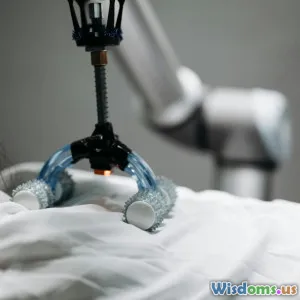
Autonomous Delivery Robots: Convenience or Security Threat
9 min read Exploring autonomous delivery robots: balancing convenience benefits with emerging security concerns. (0 Reviews)
Autonomous Delivery Robots: Convenience or Security Threat?
Introduction
Imagine ordering a package online and having it delivered right to your doorstep by a small, wheeled robot navigating busy sidewalks autonomously. This scenario is no longer science fiction but an increasingly common reality fueled by advances in robotics and artificial intelligence. Autonomous delivery robots (ADRs) promise a revolution in last-mile logistics, offering greater convenience, reduced delivery times, and potentially lower costs.
However, alongside the excitement, these robots present complex security and privacy challenges that demand our attention. While we marvel at their technological prowess, it's crucial to scrutinize the unintended risks they introduce—from cyber vulnerabilities to physical safety concerns. This article delves into the promise and perils of autonomous delivery robots, unpacking their real-world applications, advantages, and the security threats they pose.
The Convenience of Autonomous Delivery Robots
Streamlining Last-Mile Delivery
The 'last-mile' segment of delivery logistics is notoriously inefficient and expensive, sometimes accounting for up to 53% of total shipping costs. Autonomous delivery robots target this inefficiency, providing scalable solutions for transporting goods over short distances without human couriers.
Companies like Starship Technologies and Amazon Scout have deployed fleets of sidewalk robots capable of delivering food, groceries, and packages directly to customers. For instance, Starship’s robots have completed over one million deliveries globally, demonstrating practical feasibility.
Besides cost savings, ADRs reduce delivery times, especially in congested urban areas. They can operate continuously, unhindered by labor disputes or driver shortages, a growing concern highlighted during global events such as the COVID-19 pandemic.
Environmental Impact
Many autonomous delivery robots are electrically powered, emitting zero direct carbon emissions, which aligns with growing sustainability goals. According to a study by the Fraunhofer Institute, autonomous delivery robots can reduce carbon emissions by up to 90% compared to conventional delivery vans on short urban routes.
Accessibility and Contactless Delivery
ADRs enhance delivery accessibility for people unable to leave their homes easily, including the elderly or disabled, by ferrying goods directly to front doors. Furthermore, during health crises, such as the COVID-19 pandemic, contactless delivery became paramount. Autonomous robots minimize human interactions, decreasing transmission risk.
Security Threats Posed by Autonomous Delivery Robots
Cybersecurity Vulnerabilities
Despite their benefits, autonomous delivery robots introduce new vectors for cyberattacks. These robots are essentially mobile IoT devices interconnected through wireless networks, making them vulnerable to hacking.
Malicious actors could exploit software vulnerabilities to hijack robots, intercept packages, or manipulate delivery routes. For example, in a 2020 white-hat study, cybersecurity researchers were able to remotely access and control a delivery robot, prompting raises in security protocols by manufacturers.
The risk extends beyond individual theft; compromised robots could propagate malware in supply chain systems or serve as entry points for larger critical infrastructure cyberattacks.
Privacy Concerns
Many ADRs utilize cameras, LIDAR, and GPS for navigation and obstacle detection, collecting massive amounts of data in public spaces. This surveillance capability raises privacy issues related to data retention, unauthorized imagery, and potential misuse.
For instance, in San Francisco, some residents raised concerns about delivery robots capturing sensitive residential data without explicit consent, highlighting the need for transparent data policies.
Physical Safety Issues
Operating on sidewalks and shared urban pathways, ADRs must coexist safely with pedestrians, pets, and cyclists. Technical failures, sensor malfunctions, or unpredictable environments could cause accidents.
In 2019, a delivery robot in Seattle reportedly caused a pedestrian to trip, prompting discussion about regulatory standards and liability frameworks. The potential for ADRs becoming obstacles or hazards is a pressing concern for cities.
Package Theft and Vandalism
Packages left unattended in delivery robots are susceptible to theft or vandalism, diminishing consumer confidence. Unlike traditional delivery workers who confirm handovers, robots rely on secure compartments—yet these may be vulnerable, especially if robots are forcibly accessed.
Reports of ADRs being tipped over or tampered with in public demonstrate this risk, raising questions about adequate safeguards.
Balancing Innovation and Security: Real-World Insights
Regulatory and Policy Developments
Governments globally are beginning to respond to the challenges of ADR deployment. The U.S. National Highway Traffic Safety Administration (NHTSA) has issued guidelines encouraging safety features such as emergency stop buttons, speed limits, and remote operator monitoring.
Similarly, the European Union is exploring AI regulatory frameworks that encompass robotics, emphasizing data protection and accountability — crucial for mitigating privacy risks.
Industry Responses
Leading ADR manufacturers are increasingly embedding robust cybersecurity features, including end-to-end encryption, multi-factor authentication, and regular security audits. Starship Technologies, for example, publicly discloses its security protocols and collaborates with external cybersecurity experts to identify and patch vulnerabilities.
To address physical safety, many robots now include audible alerts and lights to enhance pedestrian awareness, alongside rigorous performance testing under varied urban conditions.
Community Engagement
Successful ADR integration requires transparent dialogue between operators, local authorities, and communities. Pilot programs often incorporate user feedback, helping refine robot behavior and addressing public concerns proactively.
For example, in Milton Keynes, UK, community workshops prior to deployment helped alleviate fears and foster trust.
Future Outlook: Coexistence or Concern?
As adoption grows, autonomous delivery robots are poised to become ubiquitous fixtures of urban logistics, with projected market growth estimated to exceed $1 billion by 2026.
However, this growth trajectory depends heavily on addressing current limitations and security vulnerabilities to ensure public safety and privacy.
Emerging research in AI ethics and robotics is focusing on creating "responsible robots" designed with legal and ethical frameworks embedded, while advances in blockchain may offer secure, verifiable delivery records enhancing trust.
Conclusion
Autonomous delivery robots offer remarkable convenience that can streamline delivery logistics, reduce environmental impact, and improve accessibility. Yet, the excitement around these innovations must be tempered by a clear-eyed understanding of their security and privacy risks.
From cybersecurity vulnerabilities to physical safety challenges, ADRs introduce novel security threats demanding robust technological solutions and thoughtful regulatory oversight.
As these robots become increasingly integrated into daily life, ongoing dialogue among policymakers, technologists, and communities will be essential to harness their benefits without compromising security or privacy. With responsible deployment and innovation, autonomous delivery robots can truly revolutionize urban delivery systems—delighting consumers without becoming a security menace.
References
- Fraunhofer Institute, “Environmental Impact of Delivery Robots,” 2021.
- NHTSA, "Guidance for Safe Operation of Delivery Robots," 2020.
- Starship Technologies, “Security and Privacy Policy,” 2023.
- European Commission, “AI Regulation Framework,” 2023.
- Milton Keynes ADR Pilot Program Reports, 2022.
- Cybersecurity White Hat Report on Delivery Robot Hacking, 2020.
Author's Note: This article synthesizes current research, industry standards, and community perspectives as of mid-2024 to provide an informed snapshot of autonomous delivery robots’ promise and peril.
Rate the Post
User Reviews
Popular Posts




















